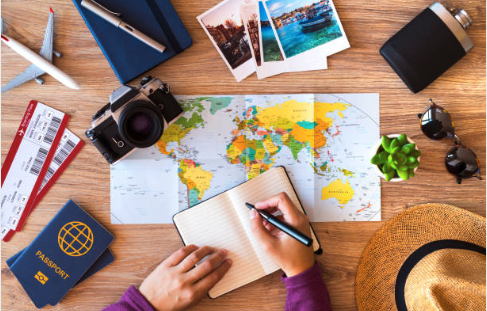Traveler Checklist
Before travel
1. PLAN
Are you comfortable/do you feel safe traveling to this place? Use this interactive map to view COVID-19 trends by location.
Understand COVID-19 guidelines and restrictions. Countries have established entry/exit requirements depending on your departure location. This may include testing requirements, quarantines and more. Check the requirements on this website.
Collect required documents Bring required documents: passport, international travel certificate, health certificate (if required), etc. Information can be found on the CIBT website.
Research re-opening activities for destination Before exploring beyond your hotel room and meeting space, check city-specific sites for your destination. For example, search “traveling to (city name) now,” and you should get a COVID-19 specific site. (Here is New York City as an example.)
Check health insurance coverage Check with your insurance to be sure you are covered outside of your home country if medical assistance is required.
Review company travel policy Understand any COVID-19 related updates to your policy and find out how to manage extended travel should the need arise.
Update your travel profile for missing or expired information As COVID-19 measures including contact tracing continue to impact the information needs of airline carriers around the world, a current mobile number and email address is required in each booking. To further enhance your travel experience, ensure all information such as your credit card, passport and other travel documentation is current.
2. PACK STRATEGICALLY
Bring a safety kit Include plenty of masks, hand sanitizer, and alcohol/disinfecting wipes. Check local security restrictions for carrying on hand sanitizer, as restrictions for carrying hand sanitizer in carry-on when flying may apply. Use alcohol wipes in flight.
Pack snacks/food Food options may be limited at the airport, in flight, and at your destination (some stores and restaurants may have reduced hours or decreased access in place). Packing food in checked luggage could mean your bag gets pulled/searched and/or goods could be confiscated so do not “over-do,” and remember it is safest to pack pre-packaged items.
Pack a color copy of your passport and driver’s license (front and back) This is just good practice. Keep copies on your person and not in checked luggage.
Pack extra medication for up to three weeks Even if you are feeling confident you will be back as planned, bring extra medication. Also bring a doctor’s note, as some countries verify limits of medications that can be brought in.
Pack comfortable shoes/clothing Whenever possible, walk to and from your destinations (offices, restaurants/grocery stores, etc.), as statistics indicate COVID-19 is less likely to spread in outdoor areas where social distancing is possible.
Pack your own work equipment Bring your own laptop, tablet, projector, charging cables, mouse, keyboard, etc. (as needed). Upload files for work-in-progress in case you are unable to return as planned.
Pack extra clothes and/or clothes that can be easily laundered in case of quarantine You may need them in the event that you fall ill or are quarantined for any reason.
During
1. LOGISTICS
Consider various ground transportation options in advance Options to get to the airport or train station might vary depending on your situation.
If using long-term parking, research options/policy; if your trip is extended due to illness or quarantine, what will happen to your car? Leave spare keys with a friend or relative and do not pre-pay with credit card in case your vehicle needs to be retrieved.
If using ride-sharing or a taxi, wipe down surfaces and open windows if possible
Allow extra time at the airport or station Allow extra time to navigate longer lines at airports and stations. Biosecurity measures during boarding, customs and other areas may take more time than usual.
If you are being taken to the airport/station: Be prepared to enter the terminal building alone and have valid boarding pass/reservation available to present if needed. Non-traveling companions will not be allowed to enter with you.
2 . EN ROUTE
Check flight information Check your airline website the evening prior and 5 hours prior. The OAG website gives you the last airline schedule changes.
If traveling by train or ferry, check information before departure Check COVID-19 related requirements and schedules.
Check origin and destination airport information Have a look at the airports’ websites, which will offer valuable information for travelers. Wipe down surfaces–seats at airport, arm-rest/tray table on aircraft, etc.
□ Most airlines require face masks but may not provide them. Bring your own masks!
□ Bring your own beverages (and snacks). Plan ahead with pre-packed snacks, and purchase beverage at airport prior to boarding. You may not have beverage service on your flight.
□ Upon landing at destination, remain seated and await crew instructions. Deplaning rules vary by airline and destination.
No matter where you are in your journey, three important reminders for extra precaution:
1.Wear a mask. 2. Practice social distancing 3. Wash your hands
3 . UPON ARRIVAL
If being picked up by friends, relatives or associates, arrange a pick-up point outside of the airport building Non-travelers may not be allowed to enter arrival terminals.
Rental car Check the car rental agencies’ COVID-19 policies.
□ Wipe down surfaces Disinfect steering wheel, vehicle controls, dashboard, seatbelt release, etc.
□ Drive with windows open Allow fresh air to circulate throughout the space
Understand and abide by local COVID-19 protocols
□ In some locations, you might be subject to quarantine or isolation. Research and familiarize yourself with local and regional restrictions. Check the requirements on this website.
□ Research what’s open, what’s not, and what options are available. Some businesses may have limited hours during the pandemic. Research food options to find out if you can dine in, if outdoor dining is available, and/or if establishments offer contactless delivery.
Rental car, ride-sharing or taxi Make your way to rental car counter or ride-sharing and taxi pick up locations as quickly as possible to avoid long lines.
4 . THE MEETING SPACE
Are masks required? Research the policies in place at the office/ meeting space you’ll be visiting to ensure you’re comfortable with the level of precautions they’re taking. In addition to wearing face masks, the WHO has recommended simple safety measures.
Does space allow for social distancing?
Will meals be served? If meals will be available, consider requesting pre-packaged options in lieu of buffet-style service.
5 . AT HOTEL
Check your destination hotel website to ensure confidence in sanitization, food availability etc. Hotel chain websites let you drill to specific property locations to learn more
Is contactless check-in available?
For extra precaution, wipe down all commonly touched surfaces Disinfect door handles, remote control, coffee maker, light switches, etc.
Call ahead to find out status of hotel services Health protocols may be in place that impact fitness centers, dining, room service, business centers, and other services you typically use while traveling.
After
1. LOCAL REQUIREMENTS
Understand your home area’s requirements following domestic and/or international travel Check the requirements on this website.
2. AT HOME
Wash and sanitize clothing, bags, work equipment, etc.
During travel, you’ll be faced with people and situations you have not been around while staying at home.
People have a wide range of responses to the pandemic, and speaking up when you’re not comfortable with someone’s behavior can be daunting. Begin by being up front about your own circumstances, and bear in mind the importance of clear communication.
Click on these links to articles from the BBC, Time Magazine and NPR to see some suggestions for politely asking others to follow safe pandemic protocols.
The information and links on this checklist are meant to provide some information on the subjects discussed. References to various websites are provided for informational purposes only and do not constitute endorsement of any websites or any particular information or advice on any website. Readers must be aware that the third-party comments and recommendations on the websites listed may change and are the content and ideas and suggestions of the third-party source and not Travia LLC.


Comment (0)